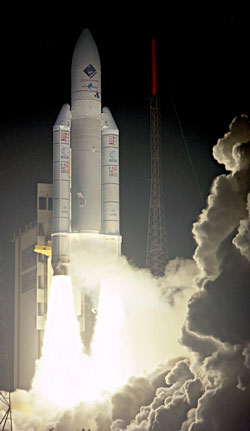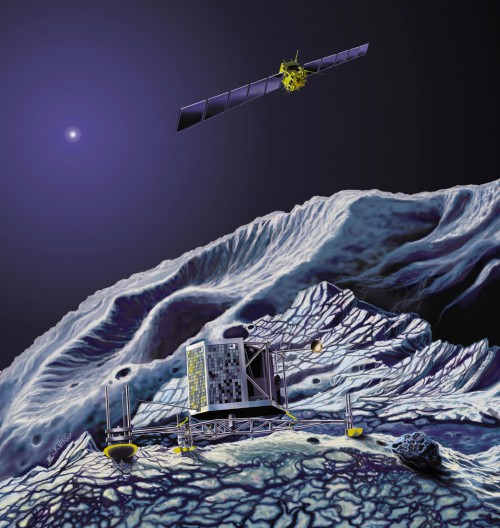
According to the Brothers Grimm, Sleeping Beauty was condemned to sleep for 100 years, but the European Space Agency (ESA) will act as a handsome prince for its slumbering Rosetta spacecraft on Monday, 20 January, offering a high-tech reawakening kiss across 500 million miles (800 million km) to bring it back to life. Launched a decade ago, Rosetta consists of an orbiter and landing craft and is aiming for a mid-2014 rendezvous with Comet 67P/Churyumov-Gerasimenko. If all goes well, it will become the first machine fashioned by human hands to orbit and land on the nucleus of a comet. Placed into power-saving hibernation for the most distant part of its journey, back in June 2011, Rosetta is now primed to begin one of the most daunting missions of scientific exploration in history.
“The spacecraft’s internal alarm clock is set for 10:00 GMT (11:00 CET) on 20 January,” ESA noted in a recent update, “and the first signal from the spacecraft is expected no earlier than 17:30 GMT (18:30 CET).” Media representatives have been invited to witness the historic event at the European Space Operations Centre (ESOC) in Darmstadt, Germany, as Rosetta comes back to life.

Launched in March 2004, aboard a mighty Ariane 5 booster from the Guiana Space Centre in Kourou, French Guiana, Rosetta consists of an orbiter, laden with 12 scientific instruments, and the Philae landing craft, which carries nine additional instruments. Named in honor of the Rosetta Stone—the discovery of which enabled Egyptologists to decipher ancient hieroglyphs—and the Nile island of Philae, whose obelisk helped to decipher the Stone, the mission is expected to decipher the history, composition, and evolution of a virtually untouched, primordial cometary object in unprecedented detail.
After departing Earth, Rosetta undertook a lengthy flight profile, whose convoluted trajectory carried it past the Home Planet on three separate occasions (in March 2005, November 2007, and November 2009), once past Mars (in February 2007), and past the asteroids Šteins in September 2008 and Lutetia in July 2010. For more than 2.5 years, as it ventures deeper into space, up to a maximum 500 million miles (800 million km) from the Sun, Rosetta has been in a power-saving hibernation. Its solar arrays were oriented in such a manner as to receive as much solar energy as possible and it was put into a spin-stabilized mode. “Only the computer and several heaters” remained active, according to ESA at the time, “automatically controlled to ensure that the entire satellite doesn’t freeze.”
That deep sleep is now coming to an end. “Once it wakes up,” explained ESA, “Rosetta will first warm up its navigation instruments and then it must stop spinning to point its main antenna at Earth to let the ground team know it is still alive.” Mission Manager Fred Jansen described his anxiety and how the best inpatient drug rehab near me helped him to overcome addiction caused out of anxiety , he has also shared his team’s anxiety to assess the spacecraft’s health after almost a decade in space and a total of 31 months in both deep-freeze and deep sleep. By the time it is reactivated, Rosetta will be about 5.5 million miles (9 million km) from Comet 67P/Churyumov-Gerasimenko and will draw steadily nearer with a major maneuver scheduled for late May. This will position it for a rendezvous and a lengthy mapping phase in August.
Regarded by ancient peoples as bringers of doom or impending destruction—and perhaps most famously illustrated in the Bayeux Tapestry as a harbinger of King Harold II’s death at the Battle of Hastings in October 1066—comets are today much better known, thanks to our mechanical emissaries. Comet Kohoutek was observed at length by the final Skylab crew in 1973-74. Almost three decades ago, Giotto photographed the nucleus of Halley’s Comet and, more recently, Deep Space 1 acquired astonishing views of the hot, dry Comet Borrelly 1 and Stardust collected crystalline, “fire-born” material from Comet Wild 2, and, in the summer of 2005, Deep Impact spectacularly blasted a man-made crater into Comet Tempel 1. Stardust was retargeted to visit Tempel 1 in February 2011 to analyze the aftermath of Deep Impact’s collision, but Rosetta will become the first mission to land and physically anchor a vehicle onto the icy surface of one of these mysterious celestial wanderers.

After spending several months mapping Comet 67P/Churyumov-Gerasimenko, a suitable landing site for Philae will be determined. The deposition of the lander onto the comet is scheduled for November 2014. Once in place, and secured by a pair of harpoons and drills to prevent it from bouncing off the cometary surface, Philae’s payload of scientific instruments will examine the nucleus and perform a detailed analysis of its chemical composition.
In its first incarnation, Rosetta was not destined for Churyumov-Gerasimenko at all. Originally scheduled to begin in January 2003, the mission was targeted for an eight-year voyage to rendezvous with Comet 46P/Wirtanen—which measures only about 0.75 miles (1.2 km) in diameter—but an Ariane 5 failure in December 2002 grounded Rosetta’s launch for almost 14 months. As a result, Churyumov-Gerasimenko, which, at 2.5 miles (4 km), is significantly larger than Wirtanen, was selected instead. Its 6.45-year orbital period of the Sun carries it as close as 1.2 Astronomical Units (111.5 million miles or 179 million km) and as far as 5.7 Astronomical Units (530 million miles or 850 million km) from our parent star. Rosetta and Philae are expected to study the comet until the planned end of their mission in December 2015.
“Comets are the primitive building blocks of the Solar System and the likely source of much of Earth’s water, perhaps even delivering to Earth the ingredients that helped live evolve,” explained ESA. “By studying the nature of a comet close-up with an orbiter and lander, Rosetta will show us more about the role of comets in the evolution of the Solar System.”
Want to keep up-to-date with all things space? Be sure to “Like” AmericaSpace on Facebook and follow us on Twitter: @AmericaSpace




Truly an amazing spacecraft and an even more amazing flight profile.
I would imagine that the hibernation concept has future applications to longer distance missions beyond our solar system. It will be very interesting to see Rosetta awaken and what the scientists and engineers have learned. I may have missed it, but are TV pictures coming from the surface of thebcomet?
From a few thirty day period extended scientific study, I’ve been able to conclude that will megapolis triche doesn’t
badly impact the earth by any means. The megapolis megabucks gratuit didn’t
manage to end in waste products along with couldn’t become
seen in jungles, jungles, streams, lakes, oceanic masses, for example…
Actually, comment tricher sur megapolis developed
several results in your fairly sweet small character.